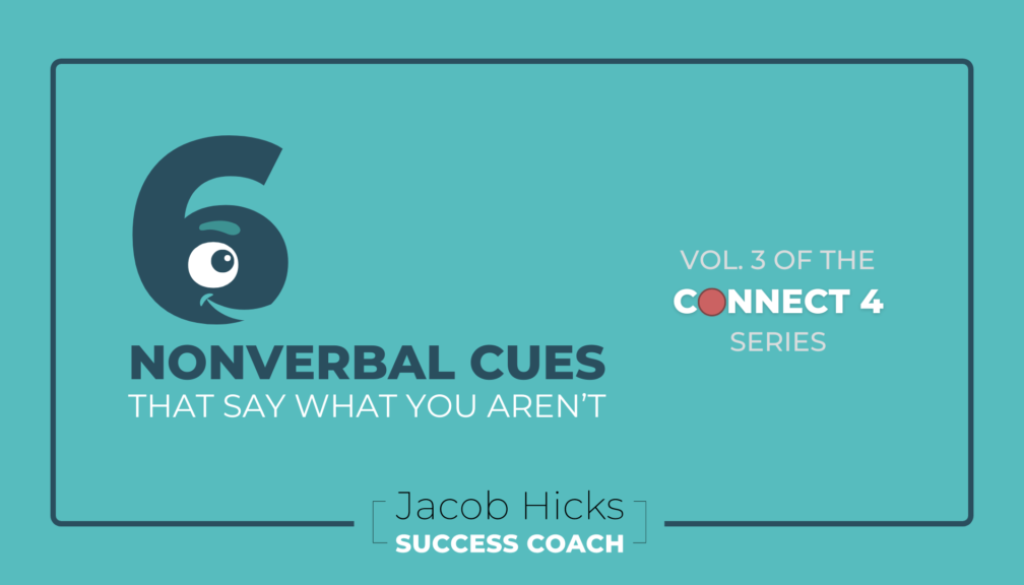6 NONVERBAL CUES THAT SAY WHAT YOU AREN’T
It won’t surprise you to find out communication is more than just words. According to some studies, what we don’t say is over HALF of what we are communicating. But how often do we actually think about what we’re not saying?? Have you ever had someone say, “It’s not what you said. It’s how you said it.” I mean it’s not just me, right? Right???
Today, I’m gonna dive into 6 nonverbal cues with strategies that will help you communicate better. Let’s go!
1. EYE CONTACT – SHOW YOU ARE GENUINELY INTERESTED
Think for just a moment of a time when you were having a conversation with someone that wouldn’t meet your eye. How did you feel? Did you feel like they weren’t really listening to you or maybe they weren’t being fully honest? Eye contact is one the easiest ways to show someone that you are engaged and plugged into what they are saying.
Strategy: Make it a point to maintain steady contact the next time you are in a conversation with someone. Not in an eye bulging, staring contest way. Just enough to show them you are genuinely present.
2. FACIAL EXPRESSIONS – REINFORCE YOUR MESSAGE
Your face mirrors your emotions but can also help people feel like they can talk with you. Have you ever been across a room and seen someone frowning? How much do you want to approach that person? Not only should your expression match what you want to say but how you want to say it.
Strategy: Practice smiling when you greet someone in person but also over the phone. They can hear the smile even when they can’t see you
Honest moment – I am very guilty of this one. I tend to frown when I am thinking about something. I have had many people tell me they didn’t feel comfortable approaching me because of it. Please reach out! I swear I am nice!!
3. BODY LANGUAGE – SHOW YOU ARE CONFIDENT AND OPEN
What do you feel when someone you are in a conversation with has their arms folded? Or when they’re slightly turned away from you? Does this feel inviting? The way you sit or carry yourself says a lot about you.
Strategy: When speaking with someone, try leaning in, don’t cross your arms, and face them directly. This conveys you are open and engaged.
4.TONE OF VOICE – EXUDE EMPATHY AND ENTHUSIASM
I have already alluded to this one a little but HOW you say something can be just as important if not more important than WHAT you say. This can make or break the message you are trying to get across.
Strategy: Pay attention to the tone you’re using. Especially if you’re discussing something sensitive in some way. Keep your voice calm and steady. We will cover this more in the next post but when our emotions start to run away with us in a confrontation, the first thing to go is our tone.
5. PHYSICAL TOUCH – CONNECT MORE WITH APPROPRIATE TOUCH
This is a big and powerful one. A touch on the hand or a hug at the right time can convey support, comfort, or connection.
Strategy: if you’re not a touchy-feely person (like me), a pat on the back, handshake, or even a high five can convey your meaning, too.
Side bar – this one ties in a ton to Love Languages. When loving someone, we need to love the way that others prefer to receive love. Not necessarily how we want to convey love. Should I do a full post on Love Languages? Shoot me a message and let me know!
6. PERSONAL SPACE – CREATE THAT SAFE SPACE
We’ve all been there. We’re talking with someone and they’re getting a little toooooo close. Step back, bruh. How close we are to people tells them a lot and can lead to frustration or discomfort.
Strategy: Read the person’s comfort level in a conversation. Being roughly an arm’s length away is often appropriate but closer can also be appropriate in more intimate settings.
____________________________________________________________________
Nonverbal cues are easy to overlook but when you take the time to consider WHAT you are going to say and HOW you are going to say it, you can find your relationships becoming stronger and more genuine.
Start small. Pick one of these strategies you feel is an area of opportunity for you and see how your conversations change.
And hey! If you found this helpful, share this with someone you want to communicate better with!
